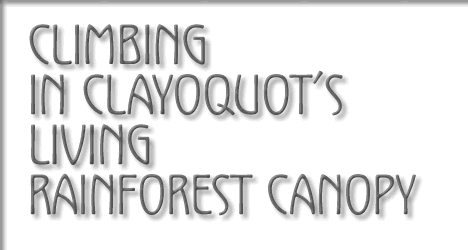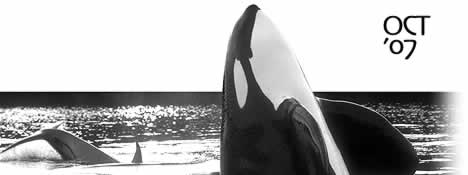
Climbing in Clayoquot’s Living Rainforest Canopy
by Alana Jung from her experiences in Tofino & Clayoquot Sound

Someone once told me of the importance of sharing secrets when getting to know people. They said that as two people begin to know each other and trust one another they often tell personal stories, take each other to favorite places and allow each other to see parts of their personality that they keep hidden from others. This summer I had the chance to get to know a few people a little better in this way. I also got to know Clayoquot Sound a little better and the secrets that the Sound revealed to me made a huge impression on me and that I would like to share some of the experiences I had with you.First, let me tell you why I came to Tofino. I arrived in April for summer work and one of my jobs was working with the Abass (Arboreal Biodiversity Across Spatial Scales) research project which is concerned with investigating arthropod (i.e. insects and mites) communities living high atop the rainforest canopy. The Abass project's goal is to address conservation of biodiversity questions and shed light on the role of arthropods in the rainforest ecosystem. There is much to learn as new arthropod species are currently still being discovered. Also, though arthropods are small they can be extraordinarily numerous. As there is strength in numbers, the effect of these tiny workers can be seen throughout the ecosystem. Arthropods, mainly made up of insect species play a large role in breaking down dead and decaying matter, cycling nutrients through the ecosystem and pollination. In order to fulfill the project's goals we routinely traveled by boat to five estuaries throughout the Sound to take samples of moss mats in the canopy and on the ground for study. Here I will take you on a trip through my best memories of the summer while working with the Abass project.
May 26, 2007: Searching for Sitka Spruce
I was sort of nervous as I stepped onto the boat. The Boston whaler was filled with people and gear. We were five; Dave, a seasoned and salty mariner with as much skill behind the helm as he has as a musician and story-teller; Kevin, a professional arbornaut and a worldly and wise man; Zoe, a brilliant scientist currently completing her doctorate who is quick to laugh and always brightening even the most foul moment; and Dr. Neville Winchester, a professor from the University of Victoria with a passion for insects, adventure and the pursuit of knowledge; and me, a student eager to get my feet wet. We pushed off from the dock and within minutes I was at ease as Dave cracked us up with his stories and the amazing scenery drew my attention.
We arrived at the Watta creek estuary with three porpoises feeding in the foreground and what seemed like a forgotten world poured out from the mist. A small creek ran down between giant green backed mountains framed by Sitka spruce, Cedar and Hemlock trees. There were next to no signs of humans and moss grew a foot deep from being left undisturbed for centuries. I accidentally overturned a moss mat as I walked around the base of a Sitka spruce and was surprised to discover a 10 cm long wandering salamander living in the mat. I was happy to think of the five of us on our mission and all the people bustling in Tofino and this little "sally" nestled in its moss mat that happily ignorant of our toiling. That day we saw all the sites and found all the Sitka spruce trees that we would take our samples from in the days to come. We also observed three wandering salamanders, one garter snake and two bears snacking on sedges by the water's edge.July 11, 2007: Moyeha River Estuary
Unfortunately, I had come down with the flu the day before this trip and I still felt pretty ill in the morning before we left. A bit of medicine went down with my morning coffee away we went. It was a sunny day and about a half-hour into the trip as the morning was just breaking through I was given my first reward for coming out that day. We were on our way past Ahousat on Flores Island when we saw an enormous flotilla of rhinoceros auklets (small black birds, flying footballs with very fancy orange horned beaks). There were over 1000 birds stretched over about 2 km. I got the feeling that I was witnessing some important event in the history of these auklets. The auklets were most likely gathering for a feast on some small forage fish. However, the feeling was similar to attending a huge protest, concert or family reunion. Seeing so many individuals align themselves in the same space and time for a common goal is something great.
On the return trip as we boated past Catface Range we saw a lone sea otter floating around in a kelp bed (my second reward)! I had never seen one before and seeing it was also great because sea otters are classified as a red listed species under the federal Species-at-Risk Act. Their populations along the coast had nearly been wiped out due to over-hunting in the recent past (in the last 200 years after European settlement). Between the years of 1969 and 1972 eighty-nine sea otters from Prince William Sound in Alaska were released in Kyuquot Sound in Northern Vancouver Island in the hopes of regaining populations. Sighting a sea otter in Clayoquot Sound hundreds of kilometers south of Kyuquot is the sign of a successful recovery project.
August 4, 2007: The Charcoal Wolf
We were at the Tranquil Inlet and had walked up the creek to our site and Dave, Neville, Zoe, Nuala (Kevin's daughter) and I were on the ground taking measurements. Kevin was half-way up a tree. We all stopped to listen to a sound from the other side of the creek at the same time. Something was barking and huffing. There shouldn't be dogs this far out and we were talking about the possibility of it being a wolf when Kevin confirms our suspicions. From his view-point at 30 m above the ground he can see a charcoal coloured wolf standing on a ridge. The wolf is alone. The huffing quickly changed to a tormented howl. The sound got further and further away until a second wolf joined in and the howling lost its edge and returned to normal. The calling continued from another twenty minutes then subsided. We must have disturbed the wolf or been close to its den.
August 26, 2007: Sydney Inlet
Here the forest is very old and untouched. There is very little understory except large ferns and the odd shrub. The trees are very large and Kevin invites us to climb one of the largest (Kevin usually climbs the trees for the Abass project - he is very experienced!). I recorded the tree to be 2 m in diameter and 56 m in height. The first limb didn't appear until 25 m up the trunk! After climbing I sat in the tree about 35 m up. When I looked out and saw the trees around me were swaying and realized that mine was swaying too I began to feel vertigo. I was incredibly aware of my senses. My heart raced, my head felt light and dizzy and my hands were white-knuckled as I gripped the trunk. Distracted by my physical condition I didn't notice what was around me very much at the time. The expansive view made it possible to watch the stream flow into the ocean and the tide slowly making it's diurnal procession, all while knowing that insects and animals around me were going about their daily routines. Looking back on that moment I get an incredible sense of time passing and the trees that were swaying back and forth around me seem like a metronome slowly keeping time.
Those were my favorite experiences with the Abass project but I don't want to mislead you. Not all scientific work is like that. Every day that we worked there were hours of preparation to be on the water by 8 am, long days outside in all sorts of weather and 6 hours for each site spent processing the samples in a damp basement. Not to mention that Zoe will need to spend the next two years looking through a microscope to sort all the arthropods collected in these samples. The field season was only a small part of the bigger picture.Along with the project's specific goals the project was significant because it got five people out and into the depths of the sound to see and experience the parts of the sound that are hidden to others. We saw wildlife that shies away from people and saw what the sound looked like before people touched it. I for one have grown closer to this place from the experiences I have had here. I now would only treat this place as I would treat a friend and I see now why people fought so hard to preserve Clayoquot Sound and would readily join in this fight.
Dr. Winchester said to me once "Canopy researchers aren't in it for the glory or the money but for scientific discovery, a sense of place, and the adventure of accessing trees by whatever means possible (be it ropes, floating raft, hot air-balloon or crane) and finding out something about the world." I think anyone with a spirit for adventure can relate. I wrote this partly to record my story but also hopefully to encourage others to explore and see what the Sound will show you.
Any questions or comments can be directed to Dr. Neville Winchester (winchest@uvic,ca) and interested people can view the UVic Research website at http://web.uvic.ca/~canopy.
tofino | tofino time | activities | accommodation | events | directory
maps | travel | food | art & artists | photos | horoscope | tides
search | magazine | issues | articles | advertising | contact us
hosted in tofino by tofino.net & studio tofino
© 2002-2014 copyright Tofino Time Magazine in Tofino Canada
Alana Jung describes her experiences in Clayoquot Sound at the Moyeha River estuary, Tranquil inlet, and Sydney Inlet as a part of the ABASS research project by UVic Entomologists.
